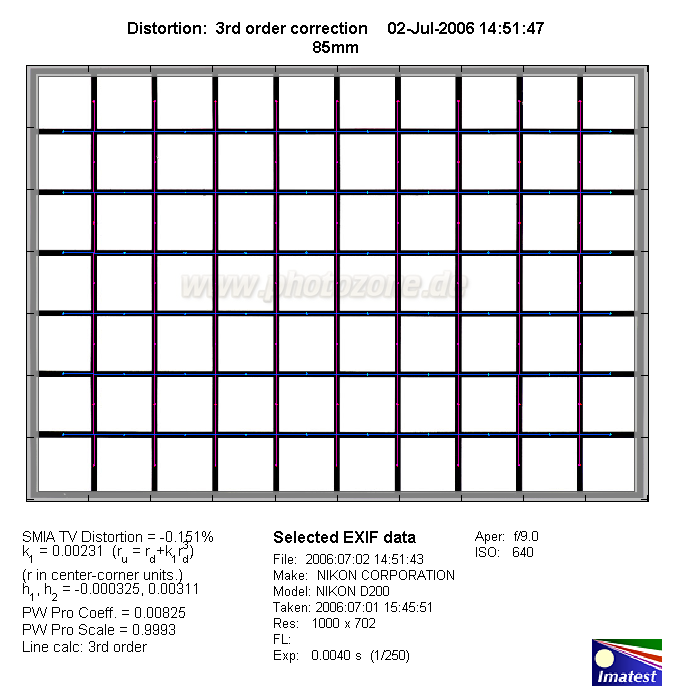|
Nikkor AF 85mm f/1.4D - Review / Test Report - Analysis |
|
Lens Reviews -
Nikon / Nikkor (APS-C)
|
|
Page 2 of 3
Distortion
The AF 85mm f/1.4D shows extremely low distortion (0.15%) which is negligible
in field conditions.

The chart above has a real-world size of about 120x80cm.
Vignetting
The AF 85mm f/1.4D is a full-frame lens so it can take advantage of a sweet spot effect
on the D200. Vignetting is very well controlled even at max. aperture with a relative
light loss of only 0.5EV which is generally irrelevant. From f/2 the issue is absolutely
negligible.

MTF (resolution)
Due to the generated stir of the initial review of this lens in several Nikon forums
I've tested a 2nd sample in the meanwhile. The new sample showed a slightly improved border
performance but the principal findings remain intact:
The AF 85mm f/1.4D didn't totally convince regarding its resolution characteristic.
The center performance is exceptionally high throughout the tested aperture range
but the border quality isn't quite on that level at large apertures due to a pronounced
degree of astigmatism or in other words: a different resolution characteristics of
sagitally (center to edge) and tangentially (around the center) lines - both values
are averaged in the provided MTF charts below.
At f/1.4 the images also suffer from reduced contrast. Stopping down does gradually
improve the border quality but the peak isn't reached till f/5.6. Very good borders are
present from f/2.8 and up which is still quite "early" in the aperture range.
Please note that resolution isn't everything and the provided sample shot above isn't
really a scene that you would shoot at this aperture setting. Lenses like the
AF 85mm f/1.4D are primarily used to achieve a minimal depth-of-field combined
with a nice bokeh (out-of-focus blur) and the Nikkor is easily capable to
provide just that.
Please note that the MTF results are not directly comparable across the different systems!
Below is a simplified summary of the formal findings. The chart shows line widths per picture height (LW/PH) which can be taken as a measure for sharpness.
If you want to know more about the MTF50 figures you may check out the corresponding Imatest Explanations
Chromatic Aberrations (CAs)
LATERAL chromatic aberrations (color shadows at harsh contrast transitions) are very well controlled
and not really field relevant.
Purple Fringing
Lateral CAs tell only one part of the CA story - purple fringing (PF) is another one.
PF can be desired as a blooming effect in out-of-focus highlights around extreme contrast
transitions. Unlike lateral CAs purple fringing cannot be easily corrected but they also
don't occur quite that often and stopping down reduces PF significantly.
At ultra-large aperture settings the Nikkor AF 85mm f/1.4D has its share of PF as you can
see in the sample portion of a fountain shot below. At f/8 the same portion doesn't even
show any traces of PF anymore. Please note that PF also seem to be dependent on the image
sensor of the camera.
| f/1.4 |
 |
f/8 |

|
Longitudinal Chromatic Aberrations (LoCA)
LoCAs (non-coinciding focal planes of the various colors) are a further aspect. Similar to
several other ultra-large aperture lenses (like the Canon EF 85mm f/1.2L)
the Nikkor also suffers from this defect. Below are two out-of-focus sample portions taken
at f/1.4 just before and behind the optimal point of focus. As you can easily notice the
halos have different colors - magenta (red + blue) and green.
You may argue that these are theoretical observations but the effect is easily field-relevant.
Please check the out-of-focus portions in the sample image with the array of statues in the
sample images chapter (see the rear statues).
|